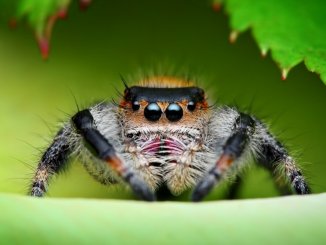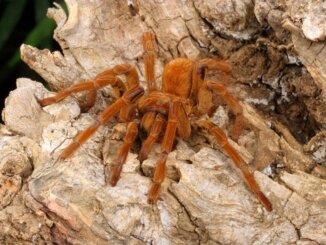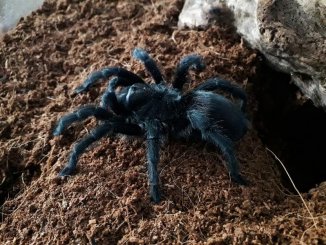Mexican red-knee tarantulas are two similar species of spider native to Mexico’s Pacific coast. Both species of Mexican red-knee have dark bodies and bright red knees, hence their names.
Caring for a Mexican red-knee spider is easy. These spiders are slow-moving and docile, and don’t mind being carefully handled.
Mexican Red-Knee Tarantula Overview

Before buying a Mexican red-knee tarantula, you should be aware of the characteristics and needs of these species, and how best to look after them.
| Species Facts | |
| Common Name | Mexican red-knee tarantula |
| Species Name | Brachypelma hamorii or Brachypelma smithi |
| Natural Habitat | Native to Mexico, prefers tropical deciduous forests, and deserts |
| Adult Size | Up to 6-inch leg span, up to 4-inch body length |
| Average Lifespan | 10 years (males), 20–30 years (females) |
| Diet | Reptiles, large insects, small mammals |
| Housing | 20-gallon tank, around 70 to 80 degrees Fahrenheit with 60 to 70 percent humidity. |
| Experience level | Beginner to intermediate |
Origin
The Mexican red-knee tarantula (Brachypelma hamorii or Brachypelma smithi) originates from the central Pacific coast of Mexico. Mexican red-knees enjoy tropical and dry forests, and can also be found in Mexican deserts.
The natural habitat of the Mexican red-knee spider is being threatened by farming and deforestation. Mexican red-knees are classed as “near threatened,” and measures have been set up to protect these spiders in the wild.
Appearance and Behavior
Mexican red-knee tarantulas can be brown, black, and red in color, with hairy bodies and long legs. The name “red-knee” refers to the bright red markings on the mid-section of the spider’s legs.
Male and female red-knee tarantulas are virtually identical in size. The only notable difference is that the females are slightly bigger than the males.
Like most other tarantulas, Mexican red-knees respond to danger by ejecting barbed hairs from their legs and abdomen. These spiders may also release a venom that is slightly irritating to human skin. However, Mexican red-knee tarantulas are docile creatures that rarely bite.
Size and Lifespan
Fully-grown Mexican red-knee tarantulas have a leg span of up to 6 inches and a body span of up to 4 inches.
Female Mexican red-knee spiders live longer than males. While male red-knees have an average lifespan of 10 years, females can live up to 25–30 years.
Temperament
The Mexican red-knee tarantula is a great pet for beginner arachnid keepers thanks to its calm, docile temperament. It’s rare that a Mexican red-knee will bite.
When Mexican red-knees feel threatened, they shoot barbed hairs from their bodies that embed into the eyes and skin of a predator. These urticating hairs can irritate human skin and cause a rash that lasts for a few hours or several days. However, the rash isn’t serious and should clear up on its own without medical intervention.
Mexican red-knee tarantulas only bite if they’re extremely aggravated. The venom of a Mexican red-knee isn’t harmful to humans, but it can be lethal for small animals and insects.
Housing Mexican Red-Knee Tarantulas
Mexican red-knee tarantulas are used to living in warm forests or desert habitats, so you should establish a similar environment in your spider’s tank.
You should use a mix of soil, vermiculite, and peat moss for the bedding or substrate, loosely packed and at least 4 inches thick. Mexican red-knees like to climb, so the thick substrate is important for softening falls. Plenty of material will also allow your Mexican red-knee tarantula to burrow and make its own hiding spots.
Fake plants are a good option to mimic the Mexican red knees natural environment. You can also add cork bark and clay flower pots to provide shelter or a place to hide.
House your tarantula in either a terrarium or aquarium. Make sure your enclosure is escape-proof, with no holes or gaps that a curious spider could squeeze through. It’s best to buy a tank with a side-opening, rather than a top opening, as Mexican red-knee tarantulas enjoy hanging from the top of the tank. Having a side-opening tank will mean you don’t have to disturb your spider every time you clean the tank.
Despite their calm temperaments, red-knee tarantulas mustn’t be housed together in the same enclosure. Even bringing these spiders together for breeding is risky, so a permanent co-housing situation won’t work. Your spiders could end up fighting to the death.
Enclosure Size
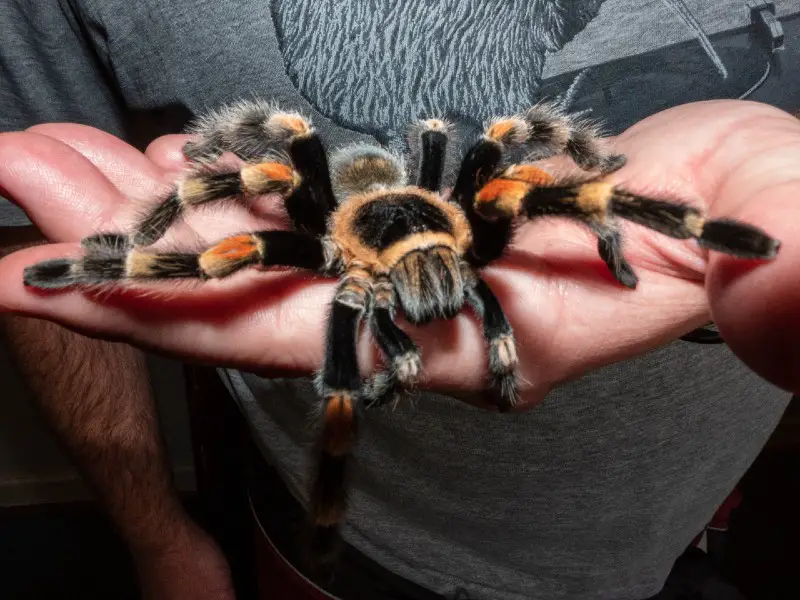
The best-sized tank for a Mexican red-knee tarantula is 20 gallons. A good rule to follow is to ensure the tank’s width is at least two times the spider’s leg span. The tank doesn’t have to be very tall. A good rule to follow is to ensure the tank’s width is at least two times the spider’s leg span, and the tank’s height is taller than the spider’s leg span if the spider is standing upright.
Choosing a large enough enclosure is essential for the well-being of your spider. Remember that your Mexican red-knee will live in its enclosure throughout its life, and it needs enough space to move and explore.
Lighting
Red-knee tarantulas don’t need any special lighting, but an LED light will help your spider distinguish between day and night. This lighting can also aid plant growth if you choose to decorate your tank with live greenery. You can set your light on a timer rather than remembering to switch it on and off yourself.
Temperature and Humidity
Proper humidity and temperature are two of the most important features of a Mexican red-knee tarantula’s tank.
You should keep the temperature of the tank between 75 and 80°F. A good way to do this is by placing a heating mat underneath one section of the tank. Although Mexican red-knees can tolerate cooler temperatures, you shouldn’t allow your tank’s temperature to drop below 60°F.
You should still make sure to give your tarantula a cooler space in the tank to prevent overheating. This is why it works best to place a heat pad in only one section of the tank.
Humidity levels should be maintained between 60 and 70%. You can often achieve this humidity with a water bowl alone, if your tank’s temperatures are correct. If your home is dryer, you may also need to mist the tank.
A good indication that your tank is too dry is if your Mexican red-knee is near to its water bowl but isn’t drinking. If your tank is too humid, your Mexican red-knee will likely hide in a corner of the tank.
You can monitor moisture by looking for condensation on the walls of the tank. While a small amount of condensation is fine, too much water can indicate that the tank is too humid for your tarantula. To measure this accurately, buy a hygrometer ( a device that can measure moisture).
Your spider could die if it overheats. Too much moisture also promotes fungal growth, so ensuring the right conditions are maintained is essential to your Mexican red-knee tarantula’s health.
Substrate and Decoration
Choosing the right substrate and decor won’t only affect your tank’s appearance. It also helps the tank maintain its humidity levels and keeps your Mexican red-knee tarantula as comfortable as possible in its environment. The right substrate can even help the spider shed its skin.
The substrate for your enclosure shouldn’t be toxic or sharp. The materials should be durable and moisture-retaining, and be biologically neutral to promote the growth of bacteria.
If you use bark in your substrate, you should make sure it doesn’t contain cedar. Good substrate materials are vermiculite, coir peat, and sphagnum peat. You can combine these materials for a substrate that will hold onto water without getting soggy. Avoid using sand, as this can clog the spider’s book lungs and cause it to die.
Although Mexican red-knees sometimes dig burrows, the substrate doesn’t need to be more than three inches deep. A good option is to lay cork bark on top of your substrate or plant rocks beneath the substrate.
You can buy decorations for your Mexican red-knee tarantula’s tank, such as clay pots and fake plants. However, if you opt for deeper substrate, you will need to make sure that no decor falls into a burrow made by your red-knee tarantula.
Cleaning
Cleaning the tank is an essential part of looking after a Mexican red-knee tarantula. Remove unwanted food from the tank when you see it, and discard all substrate if you notice any fungal growth.
Don’t use any bleaches or detergents to clean your spider’s housing. Warm water is safe and effective for this job.
While routine cleaning is important for tank hygiene, you should avoid over-cleaning. The more times you alter a balanced substrate, the more often you will disturb the entire tank environment, which could cause your Mexican red-knee tarantula to become stressed.
Clean the tank up to four times a year at most. The only exception to this rule is if problems develop in the tank, and you need to do an emergency clean.
While cleaning, place your tarantula in a separate, secure tank. This can be stressful for a Mexican red-knee tarantula, so make sure to clean as quickly as possible and bring your pet back to its familiar territory as soon as it’s safe to do so.
Mexican Red-Knee Tarantula Care
Caring for a Mexican red-knee tarantula is easy as long as you master the basics: feed your spider the right food at the right times, and handle your tarantula with care.
Food and Water
You should feed your Mexican red-knee tarantula a combination of large, live insects, like cockroaches, crickets, and locusts. Most Mexican red-knee tarantula owners raise their own insects. A cheaper option is to collect large bugs from your garden.
If you notice any bugs are still in the tank once your spider has fed, remove them and save them for next time. Crawling bugs can stress a Mexican red-knee tarantula if the spider isn’t hungry.
Small mice and lizards also make good treats for Mexican red-knee tarantulas. However, these foods can leave a mess in the tank, so you should clean away the remains immediately after feeding.
Feed your Mexican red-knee tarantula one or two times per week. Your spider will take a break from eating once a year to molt.
Handling
You can handle a Mexican red-knee spider without trouble, but correct handling is essential to prevent injury to yourself, and to prevent the tarantula from escaping.
When handling your Mexican red-knee, hold the spider less than a foot over a padded surface. This will cushion the spider’s fall if it drops. A fall of even one or two feet can seriously injure or kill a tarantula, so safe handling is essential.
Common Health Issues
Like most tarantulas, the Mexican red-knee is hardy and not prone to illness. However, this spider’s delicate exoskeleton puts it at risk of injury or death if it falls from a height. Therefore, your spider’s cage shouldn’t be too tall, and you should only handle your spider when you’re sitting down.
Mexican red-knees can also suffer from dehydration. Look for symptoms including inactivity, a shrunken midsection, and curled-under legs. If your tarantula is dehydrated, place a damp paper towel into a cup and carefully lower the spider onto the towel. Don’t place the spider in standing water, as this will cause it to drown.
Molting isn’t a health issue, but it’s something to look out for if you’re a Mexican red-knee tarantula owner. Mexican red-knees molt once a year. When molting, your tarantula will be lethargic and may lie on its back or side to ease the molting process. Your spider may not eat for several days or weeks. When molting is complete, you should take the exoskeleton out of the tank and wait for up to five days before you feed your tarantula.
Breeding
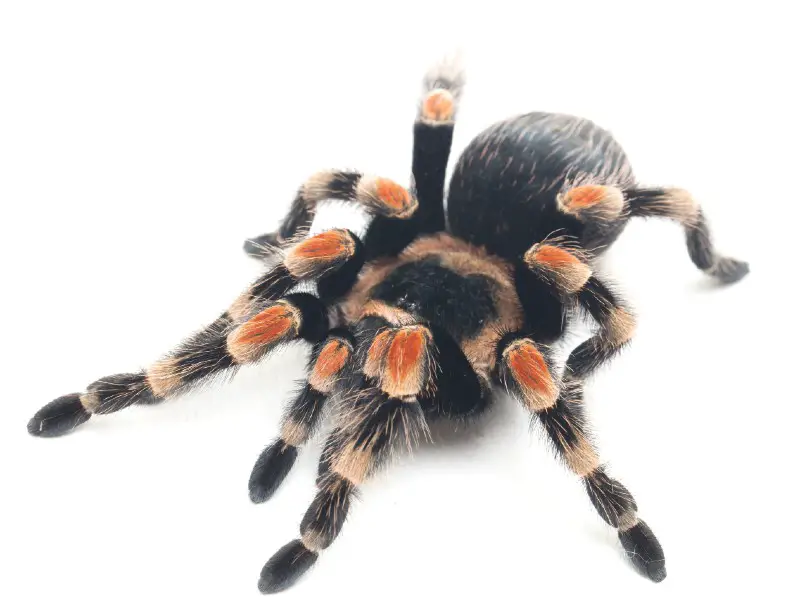
Breeding Mexican red-knee tarantulas are typically left to professional breeders, as the process can be lengthy. Before breeding, you’ll need to prepare the tank by reducing the humidity, as an overly humid environment can be off-putting to the female spider.
Wait at least 4 weeks from when your spiders have molted before breeding to ensure that the eggs are fertilized.
To successfully breed Mexican red-knee tarantulas, there are a few pointers you should remember:
- Plan mating for fall.
- Don’t introduce the male until the female is well-fed (but not obese).
- 2 months after mating, stimulate a winter for 6 to 8 weeks, with tank temperatures around 60°F. During this period, don’t attempt to touch or feed the spiders.
- After winter, slowly increase the tank’s temperature to up to 84°F. This should trigger the female to begin making her cocoon.
About 8 weeks after you see the female at the entrance to her burrow, the spiderlings will hatch. Female Mexican red-knees can lay eggs for between 150 and 550 spiderlings at a time.
Choosing and Buying a Mexican Red-Knee Tarantula
Mexican red-knee tarantulas cost around $80 to $120. The price depends on age, size, and gender. Because female Mexican red-knees live longer, they tend to be more expensive. You can buy these spiders from specialist pet stores and breeders.
It’s easy to find Mexican red-knee spiders as they’re a popular species. If possible, you should buy your spider from a breeder with plenty of experience to ensure your spider is healthy and well-adjusted. It’s illegal to catch and sell wild Mexican red-knees, so if you have any reason to be suspicious, it’s best to buy from a different seller.
Remember that any tarantula is a long-term commitment, and your Mexican red-knee may live for several decades. Only buy this spider if you’re ready for such a commitment. To make sure you’re getting the best price in your area, check local forums and shop around before purchasing.

